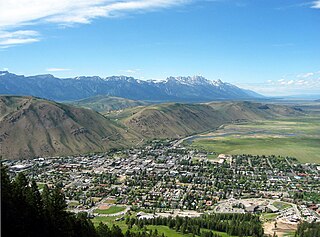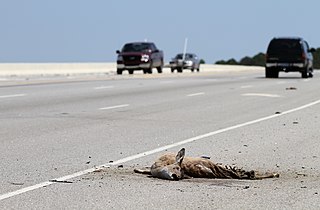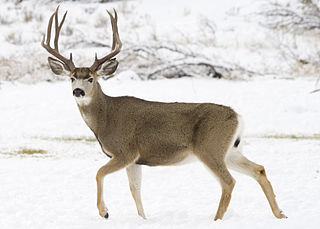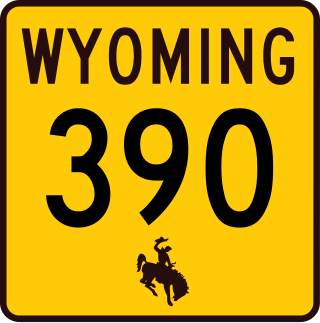
The moose or elk is the only species in the genus Alces. The moose is the tallest, and the second-largest, land animal in North America, falling short only of the American bison in body mass. It is the world's tallest, largest and heaviest extant species of deer. Most adult male moose have broad, palmate antlers; other members of the deer family have antlers with a dendritic ("twig-like"), pointed configuration. Moose inhabit the circumpolar boreal forests or temperate broadleaf and mixed forests of the Northern Hemisphere, thriving in cooler, temperate areas as well as subarctic climates.

Grand Teton National Park is an American national park in northwestern Wyoming. At approximately 310,000 acres (1,300 km2), the park includes the major peaks of the 40-mile-long (64 km) Teton Range as well as most of the northern sections of the valley known as Jackson Hole. Grand Teton National Park is only 10 miles (16 km) south of Yellowstone National Park, to which it is connected by the National Park Service–managed John D. Rockefeller Jr. Memorial Parkway. Along with surrounding national forests, these three protected areas constitute the almost 18-million-acre (73,000-square-kilometer) Greater Yellowstone Ecosystem, one of the world's largest intact mid-latitude temperate ecosystems.

Jackson is a town in Teton County, Wyoming, United States. The population was 10,760 at the 2020 census, up from 9,577 in 2010. It is the largest town in Teton County and its county seat. Jackson is the principal town of the Jackson, WY-ID Micropolitan Statistical Area, which includes Teton County in Wyoming and Teton County in Idaho. The town, often familiarly or mistakenly called Jackson Hole, derives its name from the valley in which it is located. Jackson is a popular tourist destination due to its proximity to the ski resorts Jackson Hole Mountain, Snow King Mountain, and Grand Targhee, as well as Grand Teton National Park and Yellowstone National Park.

Roadkill is an animal or animals that have been struck and killed by drivers of motor vehicles. Wildlife-vehicle collisions (WVC) have increasingly been the topic of academic research to understand the causes, and how it can be mitigated.

Jackson Hole is a valley between the Gros Ventre and Teton mountain ranges in the U.S. state of Wyoming, near the border with Idaho, in Teton County. The term "hole" was used by early trappers, or mountain men, as a term for a large mountain valley. These low-lying valleys, surrounded by mountains and containing rivers and streams, are good habitat for beavers and other fur-bearing animals. Jackson Hole is 55 miles (89 km) long by 6-to-13 miles (10-to-21 km) wide and is a graben valley with an average elevation of 6,800 ft, its lowest point being near the southern park boundary at 6,350 ft.

The mule deer is a deer indigenous to western North America; it is named for its ears, which are large like those of the mule. Two subspecies of mule deer are grouped into the black-tailed deer.

Wildlife crossings are structures that allow animals to cross human-made barriers safely. Wildlife crossings may include underpass tunnels or wildlife tunnels, viaducts, and overpasses or green bridges ; amphibian tunnels; fish ladders; canopy bridges ; tunnels and culverts ; and green roofs.

Caribou–Targhee National Forest is located in the states of Idaho and Wyoming, with a small section in Utah in the United States. The forest is broken into several separate sections and extends over 2.63 million acres (10,600 km2). To the east the forest borders Yellowstone National Park, Grand Teton National Park and Bridger–Teton National Forest. Most of the forest is a part of the 20-million-acre (81,000 km2) Greater Yellowstone Ecosystem.

The National Elk Refuge is a Wildlife Refuge located in Jackson Hole in the U.S. state of Wyoming. It was created in 1912 to protect habitat and provide sanctuary for one of the largest elk herds. With a total of 24,700 acres (10,000 ha), the refuge borders the town of Jackson, Wyoming on the southwest, Bridger-Teton National Forest on the east and Grand Teton National Park on the north. It is home to an average of 7,500 elk each winter. The refuge is managed by the U.S. Fish and Wildlife Service, an agency of the U.S. Department of the Interior.

A subway, also known as an underpass, is a grade-separated pedestrian crossing which crosses underneath a road or railway in order to entirely separate pedestrians and cyclists from motor traffic or trains respectively.

Railroad ecology or railway ecology is a term used to refer to the study of the ecological community growing along railroad or railway tracks and the effects of railroads on natural ecosystems. Such ecosystems have been studied primarily in Europe. Similar conditions and effects appear also by roads used by vehicles. Railroads along with roads, canals, and power lines are examples of linear infrastructure intrusions.

The National Museum of Wildlife Art (NMWA) is a museum located in Jackson Hole, Wyoming, United States that preserves and exhibits wildlife art. The 51,000 square foot building with its Idaho quartzite façade was inspired by the ruins of Slains Castle in Aberdeenshire, Scotland and echoes the hillside behind the facility. Located on a bluff called East Gros Ventre Butte in the midst of a real wildlife habitat, the institution overlooks the National Elk Refuge and is situated 2.5 miles north of the town of Jackson. The core of the collections reflects traditional and contemporary realism. The museum's centerpiece is a collection of works by Carl Rungius (1869–1959) and Bob Kuhn (1920–2007). In addition to 14 galleries, the museum has a sculpture trail, museum shop, restaurant, children's discovery gallery, and library. More than 80,000 people visit every year, and over 10,000 children visit the museum each year, often as part of their school curricula. The Museum is a nonprofit.

Moose–Wilson Road is a road in the U.S. state of Wyoming; the southern The 7.70 miles (12.39 km) of the road outside of Grand Teton National Park is Wyoming Highway 390 (WYO 390). The road runs about 15 miles (24 km) through the Jackson Hole valley from its intersection with WYO 22 east of Wilson on the south to Moose in Grand Teton National Park on the north end.

Moose is an unincorporated community in Teton County, Wyoming, in the Jackson Hole valley. It has a US Post Office, with the zip code of 83012. The town is located within Grand Teton National Park along the banks of the Snake River. It is populated mostly by families with inholdings within the borders of the park.

The Murie Ranch Historic District, also known as the STS Dude Ranch and Stella Woodbury Summer Home is an inholding in Grand Teton National Park near Moose, Wyoming. The district is chiefly significant for its association with the conservationists Olaus Murie, his wife Margaret (Mardy) Murie and scientist Adolph Murie and his wife Louise. Olaus and Adolph Murie were influential in the establishment of an ecological approach to wildlife management, while Mardy Murie was influential because of her huge conservation victories such as passing the Alaska National Interest Lands Conservation Act of 1980 and being awarded with the highest civilian honor, the Presidential Medal of Freedom, for her lifetime works in conservation. Olaus Murie was a prominent early field biologist in the U.S. Biological Survey and subsequent U.S. Fish and Wildlife Service before retiring and becoming the president of the Wilderness Society, He was a prominent advocate for the preservation of wild lands in America.

Olaus Johan Murie, called the "father of modern elk management", was a naturalist, author, and wildlife biologist who did groundbreaking field research on a variety of large northern mammals. Rather than conducting empirical experiments, Murie practiced a more observational-based science.
Road ecology is the study of the ecological effects of roads and highways. These effects may include local effects, such as on noise, water pollution, habitat destruction/disturbance and local air quality; and the wider environmental effects of transport such as habitat fragmentation, ecosystem degradation, and climate change from vehicle emissions.

The barrier effect of roads and highways is a phenomenon usually associated with landscape ecology, referring to the barrier that linear infrastructure like roads or railways place on the movement of animals. Largely viewed as a negative process, the barrier effect has also been found to have several positive effects, particularly with smaller species. To reduce a road or railway's barrier effect, wildlife crossings are regarded as one of the best mitigation options, ideally in combination with wildlife fencing. The barrier effect is closely linked to habitat fragmentation and road ecology.

The McArthur Lake Wildlife Corridor (MLWC) is a wildlife corridor in northern Idaho, United States. It links the wilderness areas of the Selkirk and Cabinet mountains, and is used by species such as grizzly bears that move between these areas. It also provides a wintering area for deer and other ungulates. A highway and two railway lines run through the corridor, with a strip of side roads, buildings and fences along the highway. The highway section running through the corridor has high rates of vehicle collisions with wildlife. There is limited opportunity for creating safe wildlife crossings due to the difficult terrain. Conservation groups have been active in obtaining easements on timber land to prevent further development in the corridor while allowing sustainable forestry.
A roadkill hotspot or blackspot is an accumulation of roadkill along a given length of roadway with significantly more wildlife-vehicle collisions than expected to occur by chance, based on a normal distribution. Decision-makers can then authorize the construction of roadkill mitigation infrastructure based on roadkill hotspot locations, prioritizing those with the most roadkill in number or those for a particular target species for conservation. Roadkill hotspots vary spatially and temporally, depending on the scale, duration of monitoring, and both the species and season in question. They can be calculated using roadkill survey data; GPS coordinates of roadkill collected by researchers and highway maintenance personnel, or increasingly, civilian-reported data. Additionally, roadkill hotspots can be projected by using a model to ascertain probable locations; models typically use existing wildlife abundance, distribution, and mitigation data combined with landscape variables and climatic data. Models are often used to determine the probable roadkill locations of ecologically sensitive animals or during the planning stages of a new road, it is noted that these locations may not align perfectly with sites of highest animal crossing attempts. Many academics stress the combined value of animal abundance and migration data with roadkill hotspots as a more assured way to ascertain the best locations to construct roadkill mitigation structures.
















